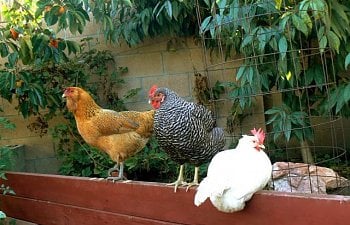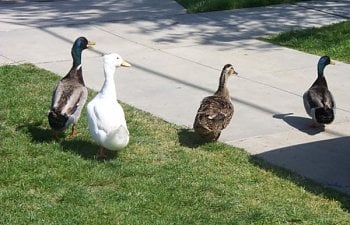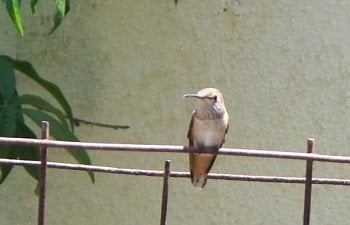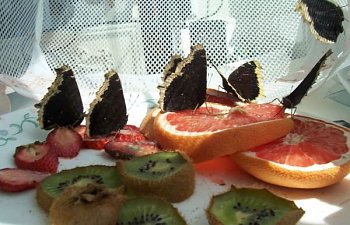Me and My Little Garden
I am a homemaker, artist, school and church volunteer, scout troop leader, and complete garden "nerd." I love gardening and any kind of edible landscaping. Southern California has the ideal climate to do it year round.
I have a blog with my chickens, garden projects, plants, insects, urban wildlife, and more of my practices of permaculture at http://hanburyhouse.com/

I have been passionate about organic gardening since a friend gave me a copy of "Organic Gardening" magazine more than 15 years ago. My front yard has most of my ornamental plants and my backyard is generally drought tolerant shade plants or edibles.

The front yard and some the less thirsty plants of recent years.
I use lots of perennials and small shrubs.

The Perlette Grape vine at the back side of the veggie garden last summer. The grape is about 5 years old.


This is the outside view of the veggie garden, April 2009. July 2009, I rebuilt the gate and fence taller and with more narrow spacing between the pickets to keep the hens out. It is now classic white like most of the garden's wooden structures.
The little city lot is filled with 12 + low chill varieties of dwarf, semi-dwarf, and standard fruit trees, raspberries, blackberries, blueberries, lots of veggies, 5 varieties of grape, and a low chill kiwi plant.

The Anna and the Dorset Golden Apple side by side against the garage. Anna needs a second apple for pollination. Dorset Golden is self fruitful.

Here is the center of my veggie garden at the end of winter.
The tortoise pen is in the back on the right behind the redwood boards.

Owari x Satsuma Dwarf Mandrine.
10 years old and 4 feet tall.
Behind on the right are the Katy Apricot and the Red Baron/ Snow Queen/ Gold Nugget Peach Nectarine combo.
Further behind this tree is the dwarf Meyer Lemon and a semi dwarf Bears lime.

Another view with the deciduous fruit trees and Japanese maples in the background.
Some are just coming into flower, late March 2009.
I was pulling weeds, so I put the pullets in the dog exercise pen behind me. It has bird netting, just in case a hawk decides to check them out.
Here is the coop the chickens live in.


Another one of my grapes leafing out. This one is called "Flame."
Three of our grapes are in the narrow space on the side of the house. The other two are "Fantasy" and "Concord." I love that the chickens keep any fallen grapes cleaned up off the ground. I just planted a new variety called Mars, in the Spring. I am hoping it will survive the chickens long enough to get tall and woody.

Some of my shade and drought tolerant backyard plants
Heliotrope and Japanese Anenome are in the foreground.
Camilla Japonica "Marie Bracey" are in the background.
Once the Camillas are established, they do okay on very limited supplemental water.
They get sun in the winter, but full shade in the summer.

Here is a view of the same flower bed from the above picture.
It is watered with only graywater from the washer machine or rainfall.
There is also the statue of Saint Francis, the patron saint of animals in here.
There are also 4 different salvias, lambs ears, snake plant (mother in law tounge,) limonium "sea lavender," ferns, sedum, and more in here. So far the chickens have pretty much left this bed alone, other than removing the mulch. Most of it isn't yummy to chickens apparently.
I have started compiling a list of the plants the chickens are leaving alone in my yard, as well as my two neighbors' yards that also keep chickens. The list is slowly growing and I try to add photos there as well.
https://www.backyardchickens.com/web/viewblog.php?id=20741-plants-chickens-dont-eat

In the foreground, Alstromeria (Inca lilies,) Clivia, lamb's ears, nastursum, bearded iris, fresia, and a few other things. They take turns through out the year dominating this spot. The fresia and clivia are winter color, the alstromeria starts in March, and the iris bloom in April and irregularly at other times.

The Baba red Raspberries are just starting to color up.
After trying many different varieties over the years, I have decided I like the consistency of this variety the best.
I also like a yellow variety," Anne."
They do well here in Southern California, as long as they only have partial shade, are well mulched, and are watered a couple of times a week in the warmer months, in addition to the winter rains.

The "Vincent" female Kiwi and "male" Kiwi"
The "Vincent" Kiwi flowers in bloom


Triple Crown Blackberries in flower

This garden arbor is the entry to the main backyard from the side of the driveway.
We get a lot of wild life around since we are close to the San Gabriel River and a long park that connects to it with a duck pond. One of the chickens had a near miss with a Praire Falcon this summer. The local wild life includes Coyotes, raccoons, 3 kinds of hawks, American kestrels, wild parrots, oppossums, egrets, cormerants, lizards, squirrels, lots of butterflies, hummingbirds, and more.
We are regularly visited by ducks from the pond across the street. They nest in the front yards of our neighborhood, and they can do some damage to the front flower beds in the spring while eating the slugs and snails. However, they are fun to watch so we live with the minimal damage. Here they are crossing the driveway as they make their rounds down the culdesac.
This hummingbird had a nest in our Chinese Elm. It was sitting on a tomato cage watching me water the veggie garden. I was surprised it stayed to let me run in and grab the camera and come back to take the photo.
Each Spring we get large numbers of Morning Cloak Butterflies laying eggs in our Chinese Elm. One year, for the kids science project, we brought the caterpillars in the house and had butterflies emerge from their chrysalis in our kitchen. We learned that Morning cloaks are fruit eating butterflies and one of the longest living, up to a year. We let them go after a few days.
My yard and garden are always changing and evolving as my interests change.
Thanks for visiting my little garden.
If you would like to see or read more about my garden and home, please visit Hanbury House.
I am a homemaker, artist, school and church volunteer, scout troop leader, and complete garden "nerd." I love gardening and any kind of edible landscaping. Southern California has the ideal climate to do it year round.
I have a blog with my chickens, garden projects, plants, insects, urban wildlife, and more of my practices of permaculture at http://hanburyhouse.com/
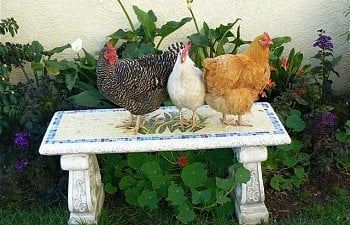
I have been passionate about organic gardening since a friend gave me a copy of "Organic Gardening" magazine more than 15 years ago. My front yard has most of my ornamental plants and my backyard is generally drought tolerant shade plants or edibles.
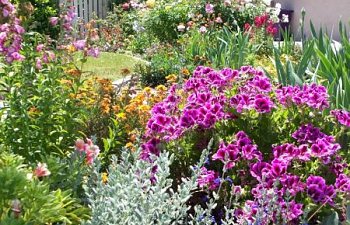
The front yard and some the less thirsty plants of recent years.
I use lots of perennials and small shrubs.
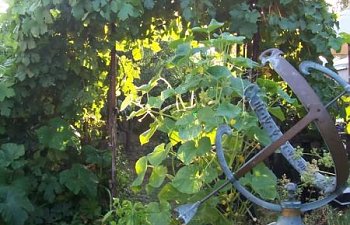
The Perlette Grape vine at the back side of the veggie garden last summer. The grape is about 5 years old.
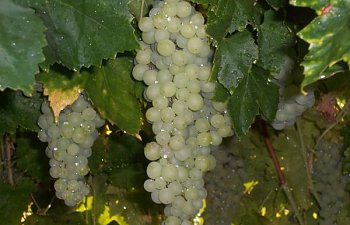
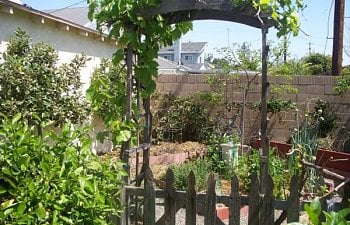
This is the outside view of the veggie garden, April 2009. July 2009, I rebuilt the gate and fence taller and with more narrow spacing between the pickets to keep the hens out. It is now classic white like most of the garden's wooden structures.
The little city lot is filled with 12 + low chill varieties of dwarf, semi-dwarf, and standard fruit trees, raspberries, blackberries, blueberries, lots of veggies, 5 varieties of grape, and a low chill kiwi plant.
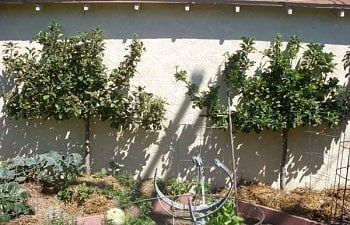
The Anna and the Dorset Golden Apple side by side against the garage. Anna needs a second apple for pollination. Dorset Golden is self fruitful.
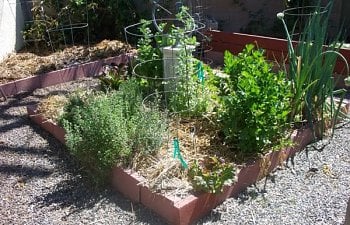
Here is the center of my veggie garden at the end of winter.
The tortoise pen is in the back on the right behind the redwood boards.
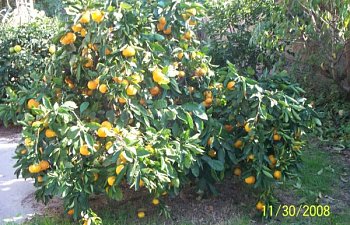
Owari x Satsuma Dwarf Mandrine.
10 years old and 4 feet tall.
Behind on the right are the Katy Apricot and the Red Baron/ Snow Queen/ Gold Nugget Peach Nectarine combo.
Further behind this tree is the dwarf Meyer Lemon and a semi dwarf Bears lime.
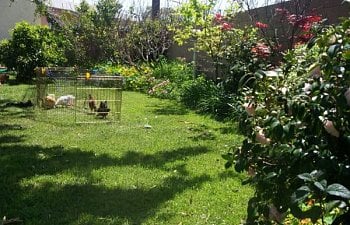
Another view with the deciduous fruit trees and Japanese maples in the background.
Some are just coming into flower, late March 2009.
I was pulling weeds, so I put the pullets in the dog exercise pen behind me. It has bird netting, just in case a hawk decides to check them out.
Here is the coop the chickens live in.
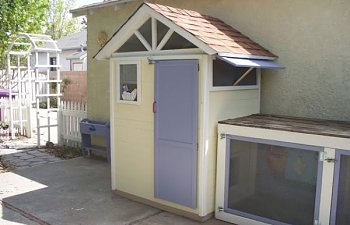
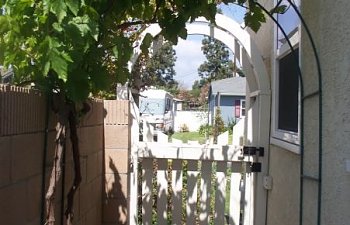
Another one of my grapes leafing out. This one is called "Flame."
Three of our grapes are in the narrow space on the side of the house. The other two are "Fantasy" and "Concord." I love that the chickens keep any fallen grapes cleaned up off the ground. I just planted a new variety called Mars, in the Spring. I am hoping it will survive the chickens long enough to get tall and woody.
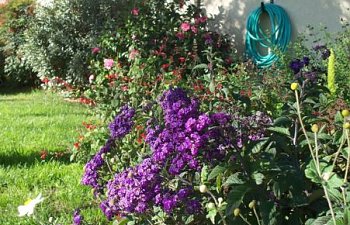
Some of my shade and drought tolerant backyard plants
Heliotrope and Japanese Anenome are in the foreground.
Camilla Japonica "Marie Bracey" are in the background.
Once the Camillas are established, they do okay on very limited supplemental water.
They get sun in the winter, but full shade in the summer.
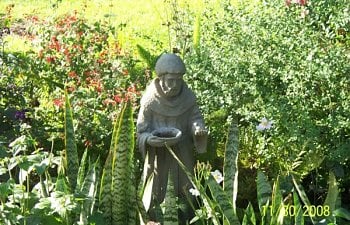
Here is a view of the same flower bed from the above picture.
It is watered with only graywater from the washer machine or rainfall.
There is also the statue of Saint Francis, the patron saint of animals in here.
There are also 4 different salvias, lambs ears, snake plant (mother in law tounge,) limonium "sea lavender," ferns, sedum, and more in here. So far the chickens have pretty much left this bed alone, other than removing the mulch. Most of it isn't yummy to chickens apparently.
I have started compiling a list of the plants the chickens are leaving alone in my yard, as well as my two neighbors' yards that also keep chickens. The list is slowly growing and I try to add photos there as well.
https://www.backyardchickens.com/web/viewblog.php?id=20741-plants-chickens-dont-eat
I built this gate 8 years ago. It was one of my earlier wood projects.
Behind it, along the edge of the back drive way, I keep some of my invasive raspberries and blackberries.
The driveway cement and the block wall keeps them well behaved and contained.
Behind it, along the edge of the back drive way, I keep some of my invasive raspberries and blackberries.
The driveway cement and the block wall keeps them well behaved and contained.
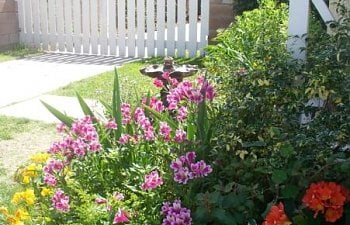
In the foreground, Alstromeria (Inca lilies,) Clivia, lamb's ears, nastursum, bearded iris, fresia, and a few other things. They take turns through out the year dominating this spot. The fresia and clivia are winter color, the alstromeria starts in March, and the iris bloom in April and irregularly at other times.
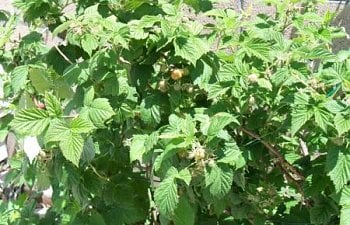
The Baba red Raspberries are just starting to color up.
After trying many different varieties over the years, I have decided I like the consistency of this variety the best.
I also like a yellow variety," Anne."
They do well here in Southern California, as long as they only have partial shade, are well mulched, and are watered a couple of times a week in the warmer months, in addition to the winter rains.
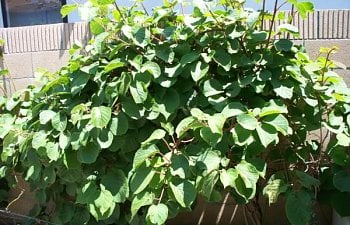
The "Vincent" female Kiwi and "male" Kiwi"
The "Vincent" Kiwi flowers in bloom
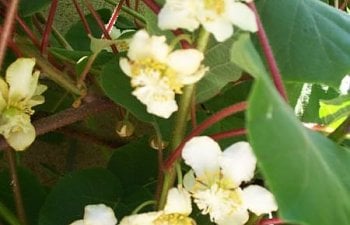
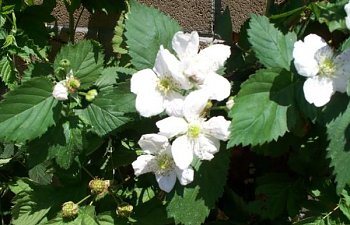
Triple Crown Blackberries in flower
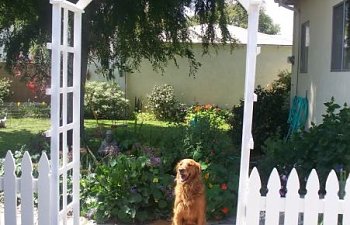
This garden arbor is the entry to the main backyard from the side of the driveway.
We get a lot of wild life around since we are close to the San Gabriel River and a long park that connects to it with a duck pond. One of the chickens had a near miss with a Praire Falcon this summer. The local wild life includes Coyotes, raccoons, 3 kinds of hawks, American kestrels, wild parrots, oppossums, egrets, cormerants, lizards, squirrels, lots of butterflies, hummingbirds, and more.
We are regularly visited by ducks from the pond across the street. They nest in the front yards of our neighborhood, and they can do some damage to the front flower beds in the spring while eating the slugs and snails. However, they are fun to watch so we live with the minimal damage. Here they are crossing the driveway as they make their rounds down the culdesac.
This hummingbird had a nest in our Chinese Elm. It was sitting on a tomato cage watching me water the veggie garden. I was surprised it stayed to let me run in and grab the camera and come back to take the photo.
Each Spring we get large numbers of Morning Cloak Butterflies laying eggs in our Chinese Elm. One year, for the kids science project, we brought the caterpillars in the house and had butterflies emerge from their chrysalis in our kitchen. We learned that Morning cloaks are fruit eating butterflies and one of the longest living, up to a year. We let them go after a few days.
My yard and garden are always changing and evolving as my interests change.
Thanks for visiting my little garden.
If you would like to see or read more about my garden and home, please visit Hanbury House.

